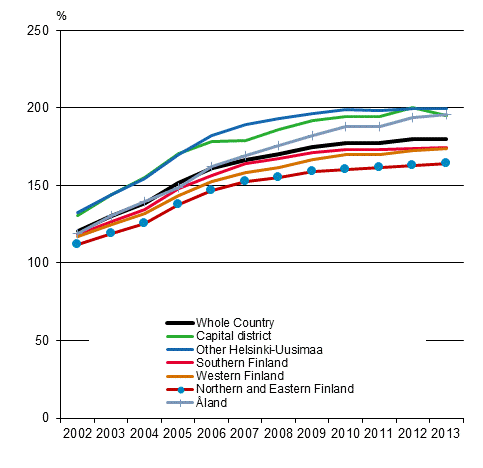Published: 23 January 2015
Housing loans 180 per cent of household-dwelling units’ annual income
Statistics Finland’s statistics on indebtedness show that the housing loan per household-dwelling unit with a housing loan amounted to nearly double their annual income in 2013. In proportion to income, the largest housing loans were found in the household-dwelling units in Greater Helsinki, elsewhere in Uusimaa and in Åland, around double their annual income. Compared to the previous year, the debts of household-dwelling units with housing loans did not grow any more.
Share of housing loans in household-dwelling units’ income in 2002 to 2013

There were 1,365,900 indebted household-dwelling units, that is, 53 per cent of all household-dwelling units. Their total debt amounted to EUR 110.1 billion. The amount of debt per indebted household-dwelling unit was EUR 80,630. Of household dwelling-units' debts, EUR 81.7 billion or 74 per cent were housing loans. Household-dwelling units' other debts, such as loans for cars, free-time residences or general consumption, amounted to EUR 20.3 billion, debt for business purposes to EUR 6.4 billion and study loans to EUR 1.7 billion.
The number of household-dwelling units whose debts were at least triple compared with disposable annual income was 265,000, making up ten per cent of all household-dwelling units. In 2002, 97,380 household-dwelling units were this much in debt, that is, around four per cent of household-dwelling units. Household-dwelling units where the reference person was aged 25 to 34 were generally the most indebted. Of the household-dwelling units in this age group, nearly one-quarter, i.e. 92,220, had debts that were at least triple compared with their annual income. Five per cent of indebted household-dwelling units, i.e. 63,840, had debts that were at least five times as high as their annual income.
During the decade, household-dwelling units' debts have gone up clearly faster than their income. From 2002 to 2013, household-dwelling units' debts doubled in real terms, while their disposable monetary income grew by 28 per cent over the same period. Housing loans grew the most, by 131 per cent. During this decade, the growth rate of debts has slowed down and in 2013 the growth of debts in real terms stopped.
In 2013, household-dwelling units paid EUR 1.9 billion in interests, of which EUR 1.2 billion were interests on housing loans. Average interest expenses per indebted household-dwelling unit were EUR 1,400. Fifty-three per cent of indebted household-dwelling units paid at most EUR 1,000 in interests and 3.5 per cent over EUR 5,000.
Source: Indebtedness 2013. Statistics Finland
Inquiries: Timo Matala 029 551 3422
Director in charge: Riitta Harala
Publication in pdf-format (188.8 kB)
- Tables
-
Tables in databases
Pick the data you need into tables, view the data as graphs, or download the data for your use.
Updated 23.1.2015
Official Statistics of Finland (OSF):
Indebtedness [e-publication].
ISSN=2489-3285. 2013. Helsinki: Statistics Finland [referred: 20.4.2024].
Access method: http://www.stat.fi/til/velk/2013/velk_2013_2015-01-23_tie_002_en.html

